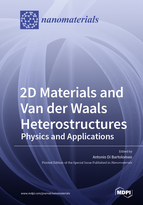2D Materials and Van der Waals Heterostructures: Physics and Applications
A special issue of Nanomaterials (ISSN 2079-4991).
Deadline for manuscript submissions: closed (31 May 2019) | Viewed by 73663
Special Issue Editor
Interests: optical and electrical properties of nanostructured materials such as carbon nanotubes, graphene, and 2D materials; van der Waals heterostructures and Schottky junctions; field-effect transistors; non-volatile memories; solar cells; photodetectors; field emission devices
Special Issues, Collections and Topics in MDPI journals
Special Issue Information
Dear Colleagues,
The advent of graphene, and more recently of layered 2D materials, has opened new perspectives in electronics, optoelectronics, energy harvesting and sensing applications. Layered 2D materials can be fabricated with relatively inexpensive production methods, integrated into existing semiconductor technologies, and offer new physical, chemical and mechanical properties. Electrically they can behave as metals, semiconductors, insulators or even superconductors. Consisting of covalently bonded and dangling-bond free lattices, they can form heterojunctions with each other or with bulk materials, without the need of a close lattice matching. In these heterojunctions, the participant materials are held together by weak van der Waals forces, which do not introduce significant changes at the atomic scale and essentially maintain the original electronic structure of the materials. Hence, van der Waals heterojunctions offer the opportunity to combine layers with different properties as the building blocks to engineer new functional materials for high-performance device or sensor applications. A great advantage is that the easy stacking of a variety of 2D materials allows a far greater number of combinations than any traditional growth method.
A great deal of work has been done thus far on the synthesis and characterization of layered 2D materials, such as graphene, transition metal dichalcogenides, hexagonal boron nitride, black phosphorus, silicene, organic perovskites, etc. Many of them have been used to fabricate stacked 2D-2D heterostructures, 2D/3D heterojunctions with common bulk semiconductors, such as Si, GaA, SiC or even 0D-2D and 1D-2D hybrids. The underlying physics and the possible applications in photodetection, biochemical sensing, strain gauges, photovoltaic energy generation or energy harvesting has been attracting the attention of both theorists and experimentalists.
The purpose of the present Special Issue is to collect state-of-the-art work on layered 2D materials and, in particular, on their van der Waals heterojunctions, both from a fundamental and application perspective. Review articles or research papers dealing with the fabrication and the properties of 2D materials and of their van der Waals heterojunctions, or with their use in electronic devices and sensors, are solicited and welcomed.
Prof. Antonio Di Bartolomeo
Guest Editor
Manuscript Submission Information
Manuscripts should be submitted online at www.mdpi.com by registering and logging in to this website. Once you are registered, click here to go to the submission form. Manuscripts can be submitted until the deadline. All submissions that pass pre-check are peer-reviewed. Accepted papers will be published continuously in the journal (as soon as accepted) and will be listed together on the special issue website. Research articles, review articles as well as short communications are invited. For planned papers, a title and short abstract (about 100 words) can be sent to the Editorial Office for announcement on this website.
Submitted manuscripts should not have been published previously, nor be under consideration for publication elsewhere (except conference proceedings papers). All manuscripts are thoroughly refereed through a single-blind peer-review process. A guide for authors and other relevant information for submission of manuscripts is available on the Instructions for Authors page. Nanomaterials is an international peer-reviewed open access semimonthly journal published by MDPI.
Please visit the Instructions for Authors page before submitting a manuscript. The Article Processing Charge (APC) for publication in this open access journal is 2900 CHF (Swiss Francs). Submitted papers should be well formatted and use good English. Authors may use MDPI's English editing service prior to publication or during author revisions.
Keywords
- 2D Materials: graphene, transition metal dichalcogenide, black phosphorus, silicene, germanene, hexagonal boron nitride
- Van der Waals heterojunctions
- Schottky and PN junctions
- Van der Waals photodiodes and phototransistors
- Field effect transistors
- Van der Waals tunneling devices and vertical transistors
- Memory devices
- Bio-chemical sensors
- Photovoltaic solar cells
- Energy harvesting devices and supercapacitors
- Ohmic and Schottky contacts







